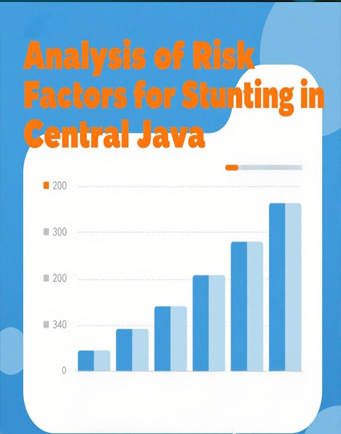Determinant Factors of Stunting Among Toddlers in Riverbank Areas: A Case-Control Study

Downloads
Stunting remains a critical issue of chronic malnutrition, especially in regions with abundant food resources but poor sanitation and nutrition education. This study aims to analyze the determinants of stunting among toddlers in the riverbank areas of Aluh-Aluh District, Banjar Regency, South Kalimantan. A case-control design was used, involving 142 children (72 cases and 70 controls) selected randomly from two villages. Variables examined include the dietary patterns of children and pregnant women, maternal nutritional status (chronic energy deficiency), exclusive breastfeeding, a history of infections, drinking water sanitation, and household food expenditure. Multivariate logistic regression revealed six significant determinants of stunting: poor maternal diet (OR=5.404), maternal undernutrition (OR=11.546), lack of exclusive breastfeeding (OR=3.198), inadequate toddler diet (OR=2.600), unboiled tap water consumption (OR=2.767), and high household food expenditure (OR=6.111). Despite being a food-rich region, the high stunting prevalence reflects structural issues in maternal education, childcare practices, and sanitation access. These findings highlight the need for contextual, integrated, and community-based interventions targeting the First 1000 Days of Life. Stunting prevention efforts should prioritize maternal nutrition education, exclusive breastfeeding promotion, improved sanitation, and the utilization of local resources and village funding.
Agustina, W., & Fathurrahman. (2022). Ibu Hamil KEK, Berat Bayi Lahir Rendah, dan Tidak ASI Eksklusif Sebagai Faktor Risiko Terjadinya Stunting. Jurnal Kesehatan Tambusai, 3(1), 263–270. https://doi.org/10.31004/jkt.v3i1.4015
Alimohamadi, Y., & Sepandi, M. (2019). Considering the design effect in cluster sampling. Journal of Cardiovascular and Thoracic Research, 11(1), 78. https://doi.org/10.15171/JCVTR.2019.14
Aritonang, E. A., Margawati, A., & Dieny, F. F. (2020). Analisis Pengeluaran Pangan, Ketahanan Pangan, dan Asupan Zat Gizi Anak Bawah Dua Tahun (Baduta) Sebagai Faktor Risiko Stunting. Journal of Nutrition College, 9(1), 71-80. https://doi.org/10.14710/jnc.v9i1.26584
Ayaviri-Nina, V. D., Quispe-Fernández, G. M., Vanegas, J. L., Ortega-Mejía, V., & Cordero-Ahiman, O. V. (2022). Importance of Purchasing Power and Education in the Food Security of Families in Rural Areas—Case Study: Chambo, Ecuador. Sustainability, 14(10), 6068. https://doi.org/10.3390/su14106068
Beal, T., Tumilowicz, A., Sutrisna, A., Izwardy, D., & Neufeld, L. M. (2018a). A review of child stunting determinants in Indonesia. Maternal & Child Nutrition, 14(4), e12617. https://doi.org/10.1111/MCN.12617
BPS Kabupaten Banjar. (2023). Kecamatan Aluh-Aluh Dalam Angka 2023. BPS Kabupaten Banjar. Retrieved from: https://banjarkab.bps.go.id/id/publication/2023/09/26/ef6090f61e4fa96e20ae2780/kecamatan-aluh-aluh-dalam-angka-2023.html
Cameron, L., Chase, C., Haque, S., Joseph, G., Pinto, R., & Wang, Q. (2021). Childhood stunting and cognitive effects of water and sanitation in Indonesia. Economics & Human Biology, 40, 100944. https://doi.org/10.1016/J.EHB.2020.100944
Campbell, A. A., Thorne-Lyman, A., Sun, K., De Pee, S., Kraemer, K., Moench-Pfanner, R., Sari, M., Akhter, N., Bloem, M. W., & Semba, R. D. (2008). Greater Household Expenditures on Fruits and Vegetables but Not Animal Source Foods Are Associated with Decreased Risk of Under-Five Child Mortality among Families in Rural Indonesia. The Journal of Nutrition, 138(11), 2244–2249. https://doi.org/10.1093/JN/138.11.2244
Desi, D., & Trihardiani, I. (2021). Sosio Kultural Masyarakat Daerah Tepian Sungai Kapuas Tanjung Hilir terkait Stunting. Jurnal surya medika, 7(1), 218-226. https://doi.org/10.33084/jsm.v7i1.2660
Dinas Kesehatan Kabupaten Banjar. (2024). Profil Kesehatan Kabupaten Banjar Tahun 2023. Dinas Kesehatan Kabupaten Banjar.
George Zipf, R. V. (2025, May 11). Design Effects and Effective Sample Size. Retrieved from: https://cran.r-project.org/web/packages/PracTools/vignettes/Design-effects.html
Ernawati, A. (2020). Gambaran Penyebab Balita Stunting di Desa Lokus Stunting Kabupaten Pati. Jurnal Litbang: Media Informasi Penelitian, Pengembangan Dan IPTEK, 16(2), 77–94. https://doi.org/10.33658/jl.v16i2.194
Fathurrahman, F., Nurhamidi, N., & Aprianti, A. (2021). Faktor Underweight pada Balita di Daerah Bantaran Sungai Martapura Kabupaten Banjar. Dinamika Kesehatan: Jurnal Kebidanan Dan Keperawatan, 12(2), 559-571. Retrieved from: https://ojs.dinamikakesehatan.unism.ac.id/index.php/dksm/article/view/763
Fauziyah, N. F., & Putri, A. S. (2023). Low birth weight and chronic energy deficiency in the mother lead to stunting: a case-control study. International Journal of Health Science and Technology, 4(3), 279–284. https://doi.org/10.31101/ijhst.v4i3.2913
Girma, M., Hussein, A., Norris, T., Genye, T., Tessema, M., Bossuyt, A., Hadis, M., van Zyl, C., Goyol, K., & Samuel, A. (2024). Progress in Water, Sanitation and Hygiene (WASH) coverage and potential contribution to the decline in diarrhea and stunting in Ethiopia. Maternal & Child Nutrition, 20(S5), e13280. https://doi.org/10.1111/mcn.13280
Gizaw, Z., Yalew, A. W., Bitew, B. D., Lee, J., & Bisesi, M. (2022). Stunting among children aged 24–59 months and associations with sanitation, enteric infections, and environmental enteric dysfunction in rural northwest Ethiopia. Scientific Reports, 12(1), 19293. https://doi.org/10.1038/s41598-022-23981-5
Govender, L., Pillay, K., Siwela, M., Modi, A., & Mabhaudhi, T. (2016). Food and Nutrition Insecurity in Selected Rural Communities of KwaZulu-Natal, South Africa—Linking Human Nutrition and Agriculture. International Journal of Environmental Research and Public Health, 14(1), 17. https://doi.org/10.3390/IJERPH14010017
Hadi, H., Fatimatasari, F., Irwanti, W., Kusuma, C., Alfiana, R. D., Asshiddiqi, M. I. N., Nugroho, S., Lewis, E. C., & Gittelsohn, J. (2021). Exclusive Breastfeeding Protects Young Children from Stunting in a Low-Income Population: A Study from Eastern Indonesia. Nutrients, 13(12), 4264. https://doi.org/10.3390/nu13124264
Harper, A., Rothberg, A., Chirwa, E., Sambu, W., & Mall, S. (2023). Household Food Insecurity and Demographic Factors, Low Birth Weight and Stunting in Early Childhood: Findings from a Longitudinal Study in South Africa. Maternal and Child Health Journal, 27(1), 59–69. https://doi.org/10.1007/s10995-022-03555-7
Humphrey, J. H. (2009). Child undernutrition, tropical enteropathy, toilets, and handwashing. The Lancet, 374(9694), 1032–1035. https://doi.org/10.1016/S0140-6736(09)60950-8
Kabahenda, M. K., & Stoecker, B. J. (2024). Associations between maternal dietary intake and nutritional status with fetal growth at 14 to 26 weeks gestation: a cross- sectional study. BMC Nutrition, 10(1), 77. https://doi.org/10.1186/s40795-024-00885-3
Kementerian Kesehatan RI. (2024). Survei Status Gizi 2024 dalam Angka. Badan Kebijakan Pembangunan Kesehatan Kemenkes RI.
Krebs, N. F., Hambidge, K. M., Westcott, J. L., Garcés, A. L., Figueroa, L., Tshefu, A. K., Lokangaka, A. L., Goudar, S. S., Dhaded, S. M., Saleem, S., Ali, S. A., Bauserman, M. S., Derman, R. J., Goldenberg, R. L., Das, A., & Chowdhury, D. (2022). Birth length is the strongest predictor of linear growth status and stunting in the first 2 years of life after a preconception maternal nutrition intervention: the children of the Women First trial. The American Journal of Clinical Nutrition, 116(1), 86–96. https://doi.org/10.1093/ajcn/nqac051
Laksono, A. D., Wulandari, R. D., Amaliah, N., & Wisnuwardani, R. W. (2022). Stunting among children under two years in Indonesia: Does maternal education matter? PLoS ONE, 17(7), e0271509. https://doi.org/10.1371/JOURNAL.PONE.0271509
Lowe, C., Kelly, M., Sarma, H., Richardson, A., Kurscheid, J. M., Laksono, B., Amaral, S., Stewart, D., & Gray, D. J. (2021). The double burden of malnutrition and dietary patterns in rural Central Java, Indonesia. The Lancet Regional Health - Western Pacific, 14. https://doi.org/10.1016/j.lanwpc.2021.100205
Ma, N., Bai, L., Niu, Z., & Lu, Q. (2024). Mid-upper arm circumference predicts the risk of gestational diabetes in early pregnancy. BMC Pregnancy and Childbirth, 24(1), 462. https://doi.org/10.1186/S12884-024-06664-Z
Mahmudiono, T., Al Mamun, A., Nindya, T. S., Andrias, D. R., Megatsari, H., & Rosenkranz, R. R. (2018). The effectiveness of nutrition education for overweight/obese mother with stunted children (NEO-MOM) in reducing the double burden of malnutrition. Nutrients, 10(12). https://doi.org/10.3390/NU10121910
Margai, F. M. (2007). Geographic targeting of risk zones for childhood stunting and related health outcomes in Burkina Faso. World Health & Population, 9(2), 64–82. https://doi.org/10.12927/WHP.2007.18943
Mbuya, M. N. N., & Humphrey, J. H. (2016). Preventing environmental enteric dysfunction through improved water, sanitation and hygiene: an opportunity for stunting reduction in developing countries. Maternal & Child Nutrition, 12(S1), 106–120. https://doi.org/10.1111/mcn.12220
Meiyetriani, E., & Utomo, B. (2025). Improved sanitation and co-occurrence of anemia and stunting in Indonesian children: A retrospective cohort study. Narra J, 5(1), e2070. https://doi.org/10.52225/NARRA.V5I1.2070
Mudadu Silva, J. R., Vieira, L. L., Murta Abreu, A. R., de Souza Fernandes, E., Moreira, T. R., Dias da Costa, G., & Mitre Cotta, R. M. (2023). Water, sanitation, and hygiene vulnerability in child stunting in developing countries: a systematic review with meta-analysis. Public Health, 219, 117–123. https://doi.org/10.1016/j.puhe.2023.03.024
Petersen, K. S., Kris-Etherton, P. M., Mccabe, G. P., Raman, G., Miller, J. W., & Maki, K. C. (2021). Perspective: Planning and Conducting Statistical Analyses for Human Nutrition Randomized Controlled Trials: Ensuring Data Quality and Integrity. Advances in Nutrition, 12(5), 1610–1624. https://doi.org/10.1093/ADVANCES/NMAB045
Picauly, I., Adi, A. A. A. M., Meiyetriani, E., Mading, M., Weraman, P., Nashriyah, S. F., Hidayat, A. T., Boeky, D. L. A., Lobo, V., Saleh, A., & Peni, J. A. (2023). Path analysis model for preventing stunting in dryland area island East Nusa Tenggara Province, Indonesia. PLOS ONE, 18(11), e0293797. https://doi.org/10.1371/journal.pone.0293797
Prabowo, B., & Peristiowati, Y. (2023). Faktor Risiko Stunting pada Balita di Indonesia. Journal of Telenursing (JOTING), 5(2), 2275–2283. https://doi.org/10.31539/JOTING.V5I2.5928
Pratiwi, I. G., & Wahyuningsih, R. (2018). Risk Factors of Stunting Among Children in Some Areas in Indonesia: A Literature Review. International Journal of Studies in Nursing, 3(3), 41. https://doi.org/10.20849/ijsn.v3i3.468
Purwestri, R. C., Barati, Z., Wirawan, N. N., Fahmi, I., Lauvai, J., & Scherbaum, V. (2018). What explains stunting among children living in a rice surplus area in Central Java, Indonesia? Diversity and Change in Food Wellbeing, 137–151. https://doi.org/10.3920/978-90-8686-864-3_7
Quamme, S. H., & Iversen, P. O. (2022). Prevalence of child stunting in Sub-Saharan Africa and its risk factors. Clinical Nutrition Open Science, 42(2), 49–61. https://doi.org/10.1016/j.nutos.2022.01.009
Rahayuwati, L., Komariah, M., Sari, C. W. M., Yani, D. I., Hermayanti, Y., Setiawan, A., ... & Kohar, K. (2023). The influence of mother’s employment, family income, and expenditure on stunting among children under five: a cross-sectional study in Indonesia. Journal of multidisciplinary healthcare, 2023, 2271-2278. https://doi.org/10.2147/JMDH.S417749
Regassa, R., Belachew, T., Duguma, M., & Tamiru, D. (2024). Factors associated with stunting in under-five children with environmental enteropathy in slum areas of Jimma town, Ethiopia. Frontiers in Nutrition, 11. https://doi.org/10.3389/fnut.2024.1335961
Salih, Y., Omar, S. M., AlHabardi, N., & Adam, I. (2023). The Mid-Upper Arm Circumference as a Substitute for Body Mass Index in the Assessment of Nutritional Status among Pregnant Women: A Cross-Sectional Study. Medicina, 59(6), 1001. https://doi.org/10.3390/MEDICINA59061001
Sentika, R., Setiawan, T., Rattu, D. J., Yunita, I., Basrowi, R. W., Masita, B. M., & Makrufardi, F. (2024). Expert Consensus on Interprofessional Collaboration (IPC) Guidelines on Stunting Management in Indonesian Primary Healthcare (Puskesmas). The Open Public Health Journal, 17(1). https://doi.org/10.2174/0118749445352608241119164446
Shinta, H. E., Utami, P. J., & Adiwijaya, S. (2020). Potential Stunting in Riverside Peoples (Study on Pahandut Urban Village, Palangka Raya City). Budapest International Research and Critics Institute (BIRCI-Journal): Humanities and Social Sciences, 3(3), 1618–1625. https://doi.org/10.33258/birci.v3i3.1092
Siddiqui, F., Salam, R. A., Lassi, Z. S., & Das, J. K. (2020). The Intertwined Relationship Between Malnutrition and Poverty. Frontiers in Public Health, 8, 453. https://doi.org/10.3389/FPUBH.2020.00453
Tasyrifah, G. M. (2021). Literature Review: Causes of Stunting in Toddlers. Muhammadiyah International Public Health and Medicine Proceeding, 1(1), 339-346. https://doi.org/10.53947/miphmp.v1i1.71
Torlesse, H., Cronin, A. A., Sebayang, S. K., & Nandy, R. (2016). Determinants of stunting in Indonesian children: Evidence from a cross-sectional survey indicate a prominent role for the water, sanitation and hygiene sector in stunting reduction. BMC Public Health, 16(1), 1–11. https://doi.org/10.1186/S12889-016-3339-8/TABLES/4
Watanabe, K., & Petri, W. A. (2016). Environmental Enteropathy: Elusive but Significant Subclinical Abnormalities in Developing Countries. EBioMedicine, 10, 25. https://doi.org/10.1016/J.EBIOM.2016.07.030
WHO. (2003). Global Strategy for Infant and Young Child Feeding. WHO. Retrieved fom: https://www.who.int/publications/i/item/9241562218
WHO. (2019). Nutrition Landscape Information System (NLiS) : Country profile indicators interpretation guide (NLiS, Ed.; 2nd edition). NLiS.
WHO. (2020). Infant and Young Child Feeding. WHO. https://www.who.int/news-room/fact-sheets/detail/infant-and-young-child-feeding
Wicaksono, R. A., Arto, K. S., Mutiara, E., Deliana, M., Lubis, M., & Batubara, J. R. L. (2021). Risk factors of stunting in Indonesian children aged 1 to 60 months. Paediatrica Indonesiana, 61(1), 12–19. https://doi.org/10.14238/pi61.1.2021.12-9
Wolf, J., Johnston, R. B., Ambelu, A., Arnold, B. F., Bain, R., Brauer, M., Brown, J., Caruso, B. A., Clasen, T., Colford, J. M., Mills, J. E., Evans, B., Freeman, M. C., Gordon, B., Kang, G., Lanata, C. F., Medlicott, K. O., Prüss-Ustün, A., Troeger, C., … Cumming, O. (2023). Burden of disease attributable to unsafe drinking water, sanitation, and hygiene in domestic settings: a global analysis for selected adverse health outcomes. The Lancet, 401(10393), 2060–2071. https://doi.org/10.1016/S0140-6736(23)00458-0
World Bank. (2021). Moving Forward: How Indonesia’s Districts Reduce Stunting. World Bank. Retrieved from: www.worldbank.org
Yani, D. I., Rahayuwati, L., Sari, C. W. M., Komariah, M., & Fauziah, S. R. (2023). Family Household Characteristics and Stunting: An Update Scoping Review. Nutrients, 15(1), 233. https://doi.org/10.3390/nu15010233
Yuliastanti, T., Ambarwati, W. N., Sulastri, S., & Rahmawati, A. (2023). History of Chronic Energy Deficiency (CED) of Pregnant Women and Stunting in Toddlers. International Journal of Nursing Information, 2(2), 7–12. https://doi.org/10.58418/ijni.v2i2.45
Yusida, H., Fathurrahman, F., & Ardiansyah, A. (2022). Gambaran Pola Asuh Anak Dan Higiene Sanitasi Terkait Kejadian Stunting di Kelurahan Telawang Banjarmasin (Studi Kualitatif). An-Nadaa: Jurnal Kesehatan Masyarakat (e-Journal), 9(2), 125-133. https://doi.org/10.31602/ann.v9i2.6750
Copyright (c) 2025 JURNAL INFO KESEHATAN

This work is licensed under a Creative Commons Attribution-NonCommercial-ShareAlike 4.0 International License.
Copyright notice
Ownership of copyright
The copyright in this website and the material on this website (including without limitation the text, computer code, artwork, photographs, images, music, audio material, video material and audio-visual material on this website) is owned by JURNAL INFO KESEHATAN and its licensors.
Copyright license
JURNAL INFO KESEHATAN grants to you a worldwide non-exclusive royalty-free revocable license to:
- view this website and the material on this website on a computer or mobile device via a web browser;
- copy and store this website and the material on this website in your web browser cache memory; and
- print pages from this website for your use.
- All articles published by JURNAL INFO KESEHATAN are licensed under the Creative Commons Attribution 4.0 International License. This permits anyone to copy, redistribute, remix, transmit and adapt the work provided the original work and source is appropriately cited.
JURNAL INFO KESEHATAN does not grant you any other rights in relation to this website or the material on this website. In other words, all other rights are reserved.
For the avoidance of doubt, you must not adapt, edit, change, transform, publish, republish, distribute, redistribute, broadcast, rebroadcast or show or play in public this website or the material on this website (in any form or media) without appropriately and conspicuously citing the original work and source or JURNAL INFO KESEHATAN prior written permission.
Permissions
You may request permission to use the copyright materials on this website by writing to jurnalinfokesehatan@gmail.com.
Enforcement of copyright
JURNAL INFO KESEHATAN takes the protection of its copyright very seriously.
If JURNAL INFO KESEHATAN discovers that you have used its copyright materials in contravention of the license above, JURNAL INFO KESEHATAN may bring legal proceedings against you seeking monetary damages and an injunction to stop you using those materials. You could also be ordered to pay legal costs.
If you become aware of any use of JURNAL INFO KESEHATAN copyright materials that contravenes or may contravene the license above, please report this by email to jurnalinfokesehatan@gmail.com
Infringing material
If you become aware of any material on the website that you believe infringes your or any other person's copyright, please report this by email to jurnalinfokesehatan@gmail.com.





































